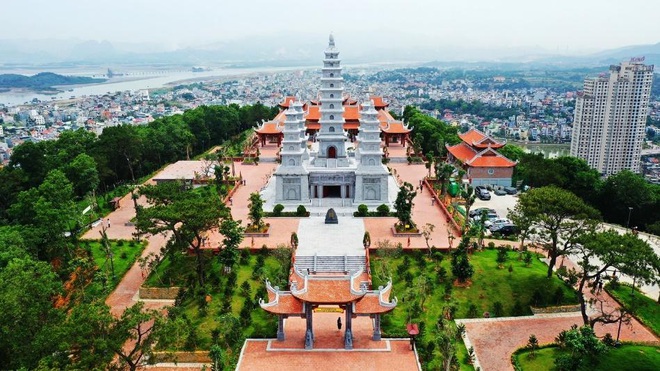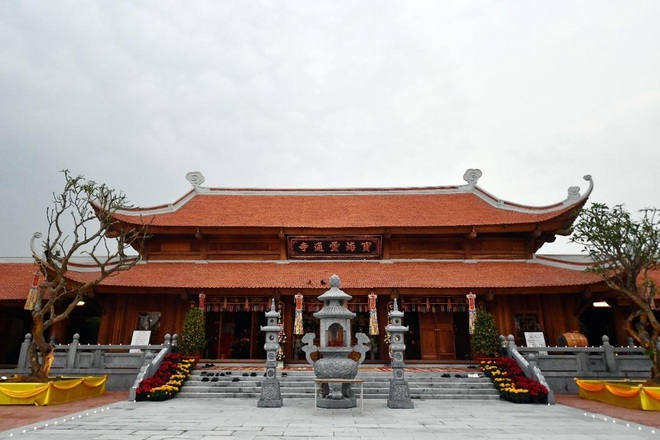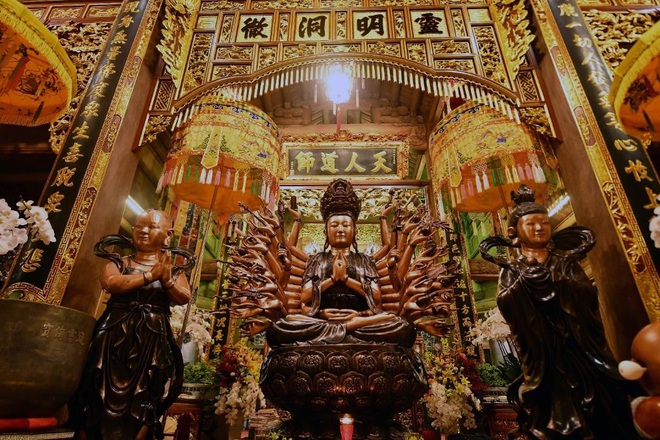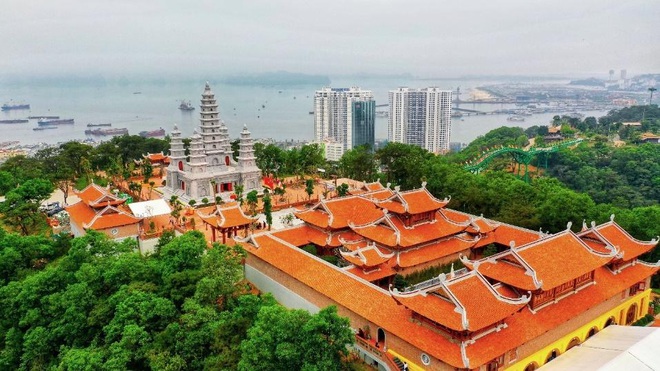Close-up of Vietnamese pagoda architecture on Ba Deo peak
Connected to the Japanese garden on the top of Ba Deo by a bridge over the green valley, Bao Hai Linh Thong
Bao Hai Linh Thong Tu is a cultural and spiritual complex located in the Sun World Halong Complex. Located in one of the most prime locations of Ha Long, on the top of Ba Deo, in the middle of the green pine forest, this complex offers an extremely expensive panoramic view. From here, visitors can take in the view of poetic Ha Long Bay in the distance and witness the rhythm of life of the vibrant coastal city surrounding the foothills.
It is also because of that unique position that the Most Venerable Thich Tri Tinh – Vice President of the Vietnam Buddhist Church Certification Council named the spiritual cultural complex on the top of Ba Deo “Bao Hai Linh”. Thong Tu”, meaning “sacred temple in the middle of a green pine hill” or “treasure to preserve and protect the coastal city of Ha Long peace and prosperity”.
To admire Bao Hai Linh Thong Tu, visitors can go from the Japanese garden (belonging to Sun World Halong Complex) through Cau May – a blue steel bridge spanning the gorge.
Immaculate with the Buddhist spirit and inheriting the long-standing traditional cultural values of the nation, Bao Hai Linh Thong Tu is a combination of the ancient Vietnamese pagoda architecture in the North in the 17th and 18th centuries and the application of creating folk visual language.
The image of the lotus – the symbolic flower of Buddhism is vividly represented in the architecture of Bao Hai Linh Thong Tu: from the overall design to the decorative motifs, shapes…
Stepping through the Tam Quan gate with comedy nose tiles, stylized decorative details in the shape of clouds, visitors will be overwhelmed with the superficial appearance and strange design of Ngu Phuong Bao Thap.
This is a special highlight in the overall architecture of Bao Hai Linh Thong Tu. The work is designed according to the model of the five Buddhas, including 5 towers, representing: 5 directions (East, West, South, North, Center), 5 sets (Bao Bo, Lien Hoa Bo, Kim Cang Bo, Karma). Department, Buddha Department) and 5 colors (blue, red, yellow, white, black).
The central tower consists of 9 floors, 25.2m high, inside is placed a Buddha image and 4m high scriptures, taken according to the sample of Buddhist scriptures dating from about 1,000 years ago at Nhat Tru Pagoda (Ninh Binh) with the wish of peace. peace for all peoples. Four towers around, each tower consists of 5 floors, 12.1m high.
Through Ngu Phuong Bao Thap, the journey to discover the magnificence of the cultural and spiritual complex on the top of Ba Deo continues to open up with a large courtyard with two sides being the Bell Tower and the Khanh Lau.
In the midst of the immense space of the mountains and the sea, the bell rings, bringing visitors’ footsteps to a place of meditation, leaving behind the yards of delusion and melancholy…
Through the large courtyard is the Tam Bao, the work is created superficially in a contemplative meditation space with bold traditional architectural influences with the design of the shape of the letter Cong (I), the architecture of two walls and roofs. The architectural imprints of Vietnamese pagodas of the 17th and 18th centuries are also vividly expressed through the roof frame in the form of “gong rack, stack of ruong” to the roof of the comedy nose, sophisticated stylized rattan motifs…
Inside the Tam Bao worships 38 bronze Buddha statues that are exquisitely crafted by Vietnam’s leading statue-casting artisans. The system of bronze statues at Bao Hai Linh Thong Tu was created according to the archetype worshiped at ancient temples in the North such as Ba Da Pagoda, Ly Quoc Su Pagoda, Hoa Ma Pagoda, Chan Tien Pagoda, King Pagoda, Mia Pagoda, and Chua Mia. Tay Phuong (Hanoi) and Vinh Nghiem Pagoda (Bac Giang)…
Behind the Tam Bao is the Ancestral House, with an area of 450m2, including three front halls and one harem. In front of the Ancestral House is a large lotus pond, in the middle of the lake is a statue of Quan Am Tu Ta (Princess Ba), created according to the prototype statue in Thien Tru cave, Huong pagoda (Hanoi).
Worshiping and praying for peace at other temples, visitors will see, usually, the Ancestral House only places the statue of Master To Dat Ma and the statues of the ancestors (abbots) of the temple. However, in Bao Hai Linh Thong Tu, beside the statue of Master To Dat Ma, the Ancestral House also has statues of Tam To Truc Lam, Tam To Tan Tong and Duc Quoc To Lac Long Quan.
As a result, in the journey to explore the space of ancient Vietnamese pagodas in Bao Hai Linh Thong Tu, visitors from all over the world have the opportunity to learn and experience more deeply Buddhist culture.
Located on both sides of the Ancestral House is the Ta Vu and Huu Vu corridors with 18 Arhat statues elaborately and sophisticatedly created according to the prototype of the Arhat statue in Tay Phuong Pagoda. If in Tay Phuong Pagoda, there are 16 Arhat statues, in Bao Hai Linh Thong Tu, next to 16 statues (taken in order from the 1st to the 16th Patriarch), there are two more statues of two Patriarchs (An Nan and Ca Diep – who was Buddha Shakyamuni’s attendant) to form a set of Arhats.
Inheriting and distilling ancient capital, the Model House at Bao Hai Linh Thong Tu is designed with 5 compartments, roofed with roof tiles, and the decorative details on the roof are styled in a sophisticated rattan shape.
Going to the end of the spiritual and cultural complex, visitors will notice the delicate and impressive stylized lotus image on each carved detail as well as flexible variations on the decorative motifs on the wooden doors and legs. columns, wooden beam system…
The architectural trick of “stacking matches on the roof” evokes the image of a lotus blooming in a lotus, creating a unique and superficial appearance for Bao Hai Linh Thong Tu.
In particular, all works belonging to Bao Hai Linh Thong Tu (except Ngu Phuong Bao Thap) are completely made of ironwood, making this place one of the few cultural and spiritual works in Vietnam today. wood construction.
The cultural and spiritual complex on the top of Ba Deo was newly built, but the design still retains the traditional features of the ancient temple architecture of the Later Le Dynasty. This is a new mark “to enrich the majestic and poetic landscape of Ha Long Bay” – as shared by Most Venerable Thich Dao Hien, Member of the Central Executive Council, Deputy Head of the Executive Board of the Buddhist Sangha. Vietnamese Catholic Church in Quang Ninh province. Follow Dan trí




